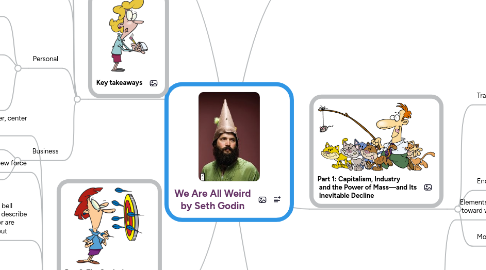
1. Part 3: The Gradual and Inexorable Spread of the Bell Curve
1.1. Mass is about the center; however, center is melting
1.2. Consumer power is the new force
1.2.1. There are many bell curves, not just one
1.2.2. Mass is no longer available
1.3. Many of the bell curves that describe our behavior are spreading out
1.3.1. Now, more and more of us can afford to make choices
1.3.2. Marketers can't afford to ignore the weird any longer
1.4. Mass and the reign of a normal education
1.4.1. There is no blob of normal
1.4.2. Instead, there are millions of individuals
1.4.3. Simple alternative to our broken system: embrace the weird
1.5. Weird is the new normal
1.5.1. There is no center
1.5.2. Just individuals and tribes
2. Key takeaways
2.1. Push to universal normal merely to help sell more junk to masses is inefficient and wrong
2.2. Everything that's not normal is weird. Right now, there is more weirdness than ever.
2.3. Opportunity: Support the weird, sell to weird, and become weird
2.4. Personal
2.4.1. We're not normal. We're weird. All of us.
2.4.2. We're at our best when we're weird, and when we're enabling others to become weird
2.4.3. Are you embracing the freedom to choose to be weird?
2.4.3.1. Make a choice
2.4.3.2. Stand up for what you believe
2.4.3.3. Do what you want
2.5. Business
2.5.1. Are you creating for fast-growing weird market or declining mass market?
2.5.2. Are you confident enough to encourage people to do what's right and useful and fun?
3. Info
3.1. Mind map by Toni Krasnic
3.1.1. http://conciselearning.com
3.1.2. Author of How to Study with Mind Maps
3.2. We Are All Weird by Seth Godin
3.2.1. Blog: http://sethgodin.typepad.com
3.2.2. Book
4. Introduction: Pregnant Elephant
4.1. Mass market success is the exception, black swan
4.2. Mass is dead. Here comes weird.
4.3. Epic battle: status quo of mass v. never-ceasing tide of weird
4.4. Definitions
4.4.1. Mass
4.4.1.1. Undifferentiated, easily reached majority
4.4.1.2. What allowed manufacturers to become efficient
4.4.2. Normal
4.4.2.1. People in the middle (masses)
4.4.2.2. Normal is localized
4.4.2.3. Amplifying normal is essential to mass traffic
4.4.3. Weird
4.4.3.1. People who aren't normal
4.4.3.2. Could be by nature or choice (focus of the book)
4.4.3.3. Key to being weird: making a choice
4.4.4. Rich
4.4.4.1. Those who can afford to make choices about how they live
4.4.4.2. Those who can make an impact on their tribe
4.4.5. Tribes share
4.4.5.1. Leader
4.4.5.2. Culture
4.4.5.3. Definition of normal
5. Part 1: Capitalism, Industry and the Power of Mass—and Its Inevitable Decline
5.1. Tradition
5.1.1. Factory comes first, which requires mass markets
5.1.2. Bias on masses and conformity; shun outliers
5.1.3. Average products for average people
5.2. End of mass market
5.2.1. The tide has turned, and it's actually a good thing
5.2.2. More info, choice, freedom, interaction; more weird
5.2.3. Normal is not who we are or where we're going
5.3. More choice, less mass; more weird
6. Part 2: The Four Forces for Weird
6.1. Elements of society shifting away from normal toward weird
6.2. 4 Forces
6.2.1. Creation is amplified
6.2.1.1. Creation is easier and faster
6.2.1.2. Anyone, anywhere can publish to the world and make an impact
6.2.1.3. Amplification changes creator and tribe
6.2.2. Rich allows us to do what we want, and we want to be weird
6.2.2.1. No longer focused on just survival
6.2.2.2. Rich enough to care about choice
6.2.3. Marketing is far more efficient at reaching the weird
6.2.3.1. The long tail
6.2.3.2. Marketers have shifted gears toward weird
6.2.3.3. Easier to reach pockets of weird people
6.2.4. Tribes are better connected
6.2.4.1. Easy to find others who share your interests
6.2.4.2. Weird is becoming more normal
